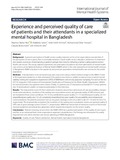Experience and perceived quality of care of patients and their attendants in a specialized mental hospital in Bangladesh

View/
Date
2019-06-22Publisher
BMCAuthor
Nuri, Nazmun NaharSarker, Malabika
Ahmed, Helal Uddin
Hossain, Mohammad Didar
Beiersmann, Claudia
Jahn, Albrecht
Metadata
Show full item recordCitation
Nuri, N. N., Sarker, M., Ahmed, H. U., Hossain, M. D., Beiersmann, C., & Jahn, A. (2019). Experience and perceived quality of care of patients and their attendants in a specialized mental hospital in Bangladesh. International Journal of Mental Health Systems, 13(1) doi:10.1186/s13033-019-0303-xAbstract
Abstract
Background: A person’s perception of health service quality depends on his or her expectations and priorities. If
the perception of care is good, then it eventually enhances future health service utilization, adherence to treatment
and desired outcomes. Understanding a patient’s perspective is key for delivering a better quality patient-centred
health care service. This study explored experience and perception of patients and their attendants of mental health
care services at the National Institute of Mental Health (NIMH) which is the only national level mental health institute
in Bangladesh. NIMH is located in the capital city and provides specialized mental health care services for the whole
population.
Methods: A facility-based cross-sectional study was conducted using a mixed-method design at the NIMH. A total
of 40 respondents (patients, or their attendants if the patient was minor or unable to respond due to lack of mental
stability) visiting the outpatient department (OPD) of NIMH were selected by purposive sampling. For each of the ten
ICD 10 categories (10th revision of International Classifcation of Diseases by the World Health Organization [WHO])
for mental disorders, four patients were chosen. Finally, 13 patients and 27 attendants (on behalf of 17 minor patients
and 10 adult patients unable to respond) participated in the interview.
Results: The respondents rated 34 short statements clustered around four dimensions of care (accessibility, interpersonal communications, condition of the waiting and consultation rooms, and general quality of OPD services) and
we interpreted those scores as follows: 7.6–10 very satisfed/very good quality, 5.1–7.5 satisfed/good quality, 2.6–5.0
dissatisfed/poor quality and 1.0–2.5 completely dissatisfed/very poor quality. For accessibility and interpersonal
communications, the patients perceived care as very good (average scores on a Likert scale of 1–10 were 8.3 and 7.6,
respectively). The respondents considered the condition of the waiting and consultation rooms and general quality of
OPD care as good (average scores 5.8 and 7.1, respectively). NIMH had serious lack of resources in terms of functional
medical equipment and physicians appointed, which negatively impacted on the service quality.
Conclusions: Patients receiving services from the NIMH OPD had a positive perception of the quality of care in general. But, at an individual level, some respondents expressed dissatisfaction. Our fndings are informative for quality
improvement and client-oriented care service planning at NIMH, Bangladesh.
